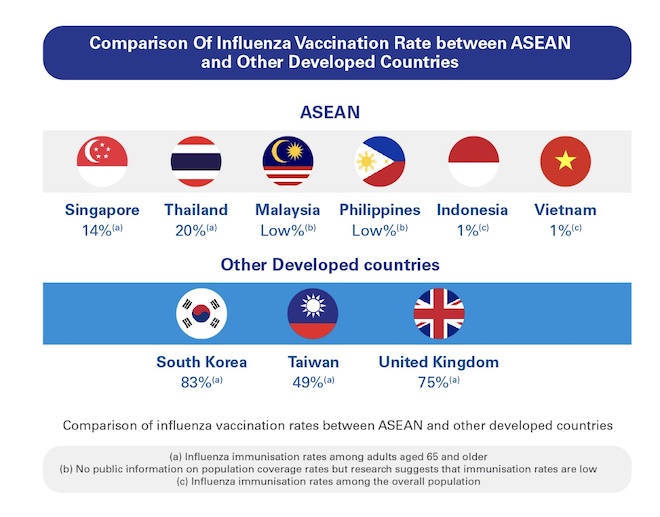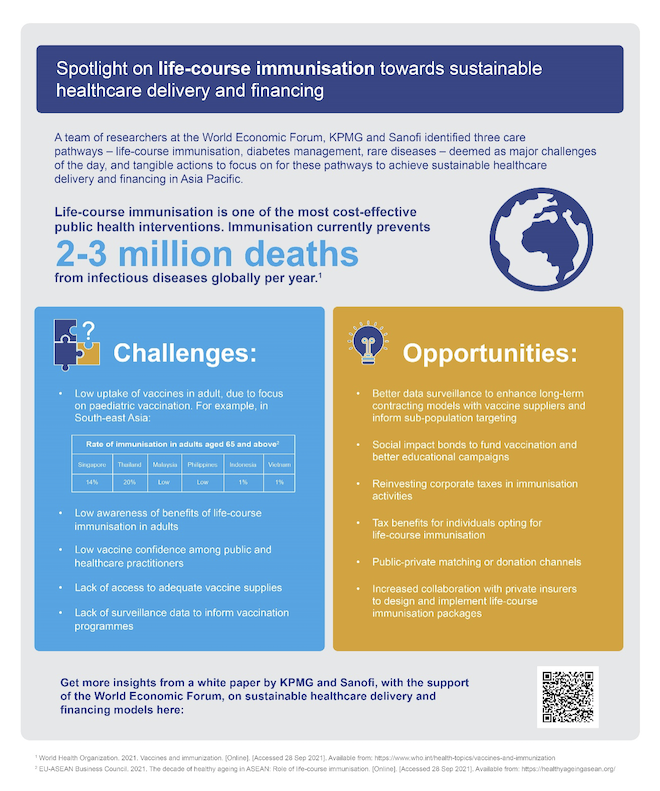Companies news • Analyses & Studies • Publications
Rethinking Healthcare in Southeast Asia through Life-Course Immunization and Sustainable Vaccine Financing

By 2050, more than 62% of the population in Asia will be made up of those aged 65 and older, making the region the oldest globally. Photo credit: ADB
This article is published in collaboration with Sanofi.
Southeast Asia’s healthcare systems are highly diverse and complex, with in-country and between-country differences in access, quality, and coverage. Despite differences in capacity and capability to respond to current healthcare challenges, there is an urgent need for the region to look ahead to a common future challenge—the increasing burden of aging populations, driven by falling fertility rates and increases in life expectancy.
By 2050, more than 62% of the population in Asia will be made up of those aged 65 and older, making the region the oldest globally. Many countries in Southeast Asia are also among those with the most rapidly aging population globally.1 For example, between 2020 and 2050, the elderly population in Thailand will shift from 13% to 30%, representing the fifth largest percentage point increase globally.2 Along with this demographic shift, the region will grapple with the rising challenge of non-communicable and infectious diseases, due to a decline in health in older age.
Traditional forms of healthcare financing include tax- or employer-funded schemes, neither of which is suitable to meet the current and future healthcare challenges in the region. The tax-to-GDP ratio in Asia Pacific is below 15%, which is below the target for sustained economic growth.3
A growing aging population in the future will generate lower levels of taxation, due to reduced workforces. There is also growing informal workforces in the region, whose employment is not captured by the tax system. Moreover, private insurance may not capture entire populations, specifically in developing countries, where the penetration rate of private insurance is less than 5%.
Current health systems are already struggling to cope with addressing existing disease burdens, which is further exacerbated by the coronavirus disease (COVID-19) pandemic. The third World Health Organization (WHO) Global Pulse Survey, conducted in late 2021, found that health systems globally continue to be severely impacted by the COVID-19 pandemic, with little to no improvement since early 2021.4 There is an opportunity to rethink the ways in which we deliver and finance healthcare, so future populations can lead fulfilling and healthy lives.

The value of sustainable life-course immunization
The COVID-19 pandemic has further spotlighted the importance of preventative care for improved health outcomes, specifically by immunizing the healthy to control transmission in communities. The age-old saying, "prevention is better than cure" rings truer than ever. As well as tackling all aspects of when someone needs healthcare—from diagnosis to treatment to monitoring—we need to focus on prevention. A key aspect of prevention is life-course immunization.
Vaccination has been recognized by WHO and many medical professionals as one of the most cost-effective and -efficient methods of disease prevention. A life-course approach to healthy aging is embodied in the vision of the WHO Immunization Agenda 2030 and the UN Decade of Healthy Ageing.
Life-course immunization—or vaccination throughout the course of one’s life—can prevent up to three million deaths from infectious diseases annually and is one of the most cost-effective public health interventions.5 It prevents future illnesses from arising and reduces the strain of ongoing illnesses, including endemic infectious diseases.
In terms of economic benefits, an analysis on 94 low- and middle-income countries concluded a $44 return on every $1 spent on immunization.6 Looking at other regions, a study in the United States found cost savings of more than $15,000 per quality-adjusted life-year in adults aged 65 and above.7
Yet, uptake rates beyond pediatric immunization in Southeast Asia continues to be low. For example, the rates of influenza vaccination for those aged 50 and above in Singapore is under 20%, and in Thailand, around 34% of older adults had taken the influenza vaccination.8 While these rates are far below the target set by WHO at 75%,9 they are some of the highest uptake rates in the region.

Source: https://healthyageingasean.org/
In 2017, government healthcare budgets in Asia Pacific allocated to preventative care were around 8%.10 There is an opportunity to allocate further funds to areas such as life-course immunization, where it has the potential to maximize healthcare impact while optimizing precious healthcare resources. At the same time, more innovative models of funding are needed in order to combat the challenges that an aging population and a gig economy has on healthcare funding. Policy makers should revisit the life-course immunization financing models being used to drive sustainability.
Sustainable financing models for life-course immunization
To ensure sustainable healthcare financing, it is crucial to have multiple—as well as innovative—sources of funding, and those that are beyond the traditional models of financing. For example, in Singapore, a co-pay system, MediSave, which diverts 7%–9.5% of wages into a "medical" account, allows adults to draw from this account to benefit from subsidized vaccination, such as for influenza. Policy makers could consider adopting a co-payment adult immunization financing system that combines the best of both taxes and social insurance model.
In addition, dedicated earmarking taxes for life-course immunization can be explored. For example, Taipei,China earmarked taxes on tobacco, to procure new vaccines for its national immunization programs.11
Leveraging on public-private partnerships, such as the reinvestment of corporate taxes in immunization activities, offering tax benefits for individuals who have opted for immunization, or the design of insurance packages that implements and incentivizes life-course immunization or other preventive care are all worth considering. For example, private insurers may offer reduced premium payments for policyholders who attend annual checkups and adult immunization.
Social impact bonds are an emerging novel financing mechanism, wherein private organizations invest in public-sector programs that aim to deliver a desired social outcome. By its nature, bonds promote ecosystem collaboration, which is an effective driver to promote preventative healthcare, such as life-course immunization.
It is also important to invest in holistically financed life-course immunization programs, such as the incorporation of surveillance data gathering, so it informs policy makers on long-term contracting models to mitigate supply and demand issues, as well as sub-population targeting to ensure it reaches the most vulnerable and marginalized communities.

The way forward
Even though implementing life-course immunization programs may have initial logistical and funding challenges, the alternative—not leveraging on the benefits of preventative care—will have more health, economic and social consequences. There is a huge opportunity to tap into the growing awareness of vaccines and the value of immunization that has emerged out of the COVID-19 pandemic and extend it to other disease areas.
Southeast Asia should urgently prioritize life-course immunization as a vital pillar for healthy aging, recognizing its value as a fundamental driver of socio-economic benefit—and a key to realizing a sustainable future for the region's healthcare systems.
This article is based on a white paper, UHC 2.0: Charting a Course to Sustainable Healthcare and Finance in the Asia-Pacific, by the World Economic Forum, in partnership with Sanofi and KPMG.

References
1 Menon J & Melendez-Nakamura A. (2009). Aging in Asia: Trends, Impacts and Responses: Working paper series on regional economic integration no. 25. Asian Development Bank.
2 United Nations, Department of Economic and Social Affairs, Population Division (2019). Probabilistic Population Projections Rev. 1 based on the World Population Prospects 2019 Rev. 1. [Online]. Available from: population.un.org/wpp/
3 The World Bank. (2022). Tax revenue (%of GDP). [Online]. Available from: data.worldbank.org/indicator/GC.TAX.TOTL.GD.ZS
4 World Health Organization. (2022). Essential health services face continued disruption during COVID-19 pandemic. [Online]. Available from: www.who.int/news/item/07-02-2022-essential-health-services-face-continued-disruption-during-covid-19-pandemic
5 World Health Organization. (2019). Immunization. [Online]. Available from: www.who.int/news-room/factsin-pictures/detail/immunization
6 Ozawa S, Clark S, Portnoy A, et al. (2016). Return On Investment From Childhood Immunization In Low- And Middle-Income Countries, 2011–20. Health Affairs. 35(2): 199-207.
7 Dabestani NM, Leidner AJ, Seiber EE, et al. (2019). A review of the cost-effectiveness of adult influenza vaccination and other preventive services. Preventive Medicine. 126(105734).
8 Praphasiri P, et al. (2017). Predictors of seasonal influenza vaccination among older adults in Thailand. PLOS ONE. Available at journals.plos.org/plosone/article;
9 World Economic Forum, KPMG & Sanofi. (2021). UHC 2.0: Charting a Course to Sustainable Healthcare and Finance in the Asia-Pacific. [Online]. Available from: www.weforum.org/whitepapers/uhc-2-0-charting-a-course-to-sustainable-healthcare-and-finance-in-the-asia-pacific
10 Organisation for Economic Co-operation and Development. (2020). Health at a Glance: Asia/Pacific 2020 : Measuring Progress Towards Universal Health Coverage. [Online]. Available from: www.oecd-ilibrary.org/sites/377d54fa-en/index.html
11 Thinkwell. (2017). Sustainable immunization financing in Asia Pacific: Taipei,China country brief. [Online]. Available from: https://thinkwell.global/wp-content/uploads/2018/09/Taiwan-Country-Brief-081618.pdf


